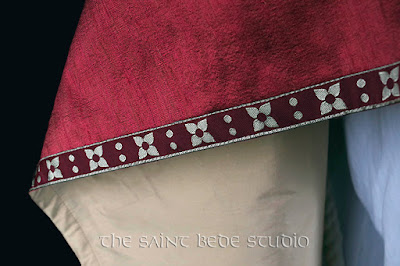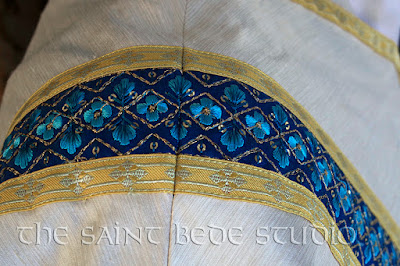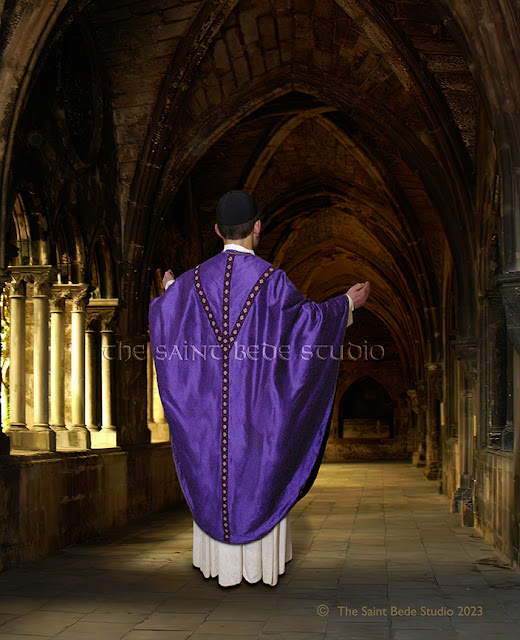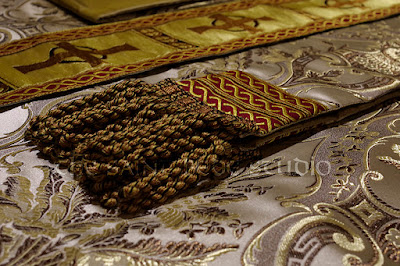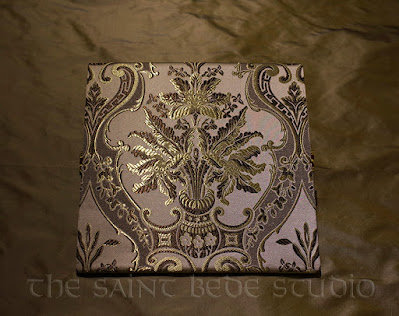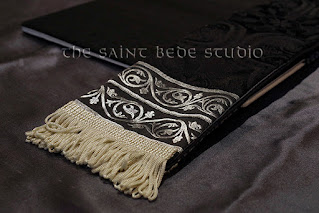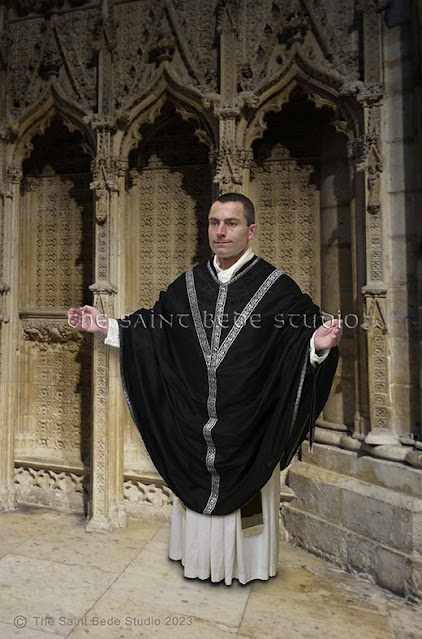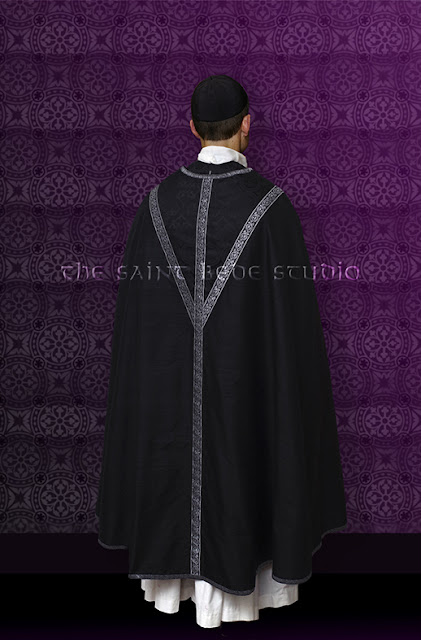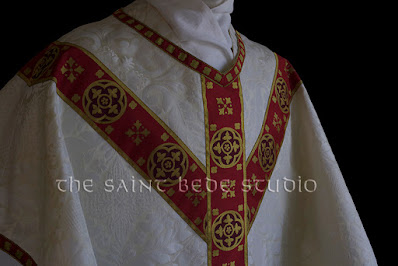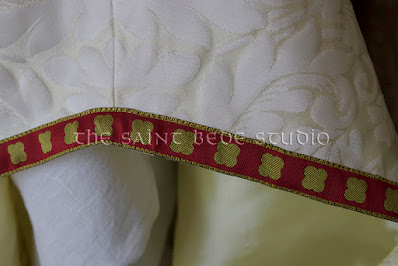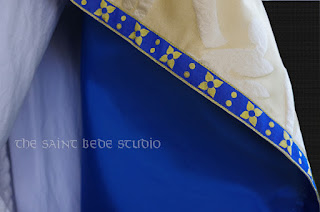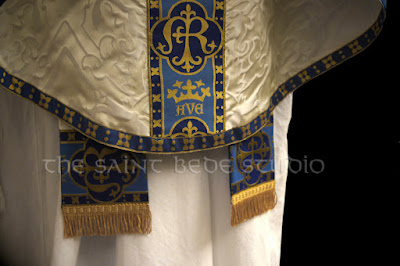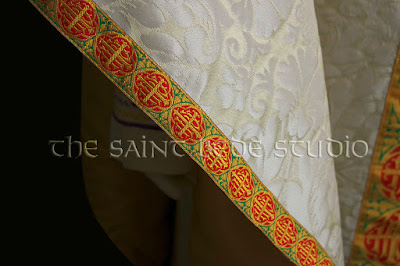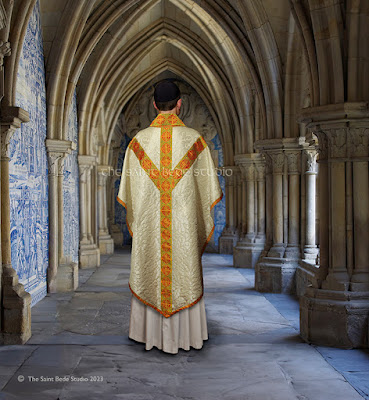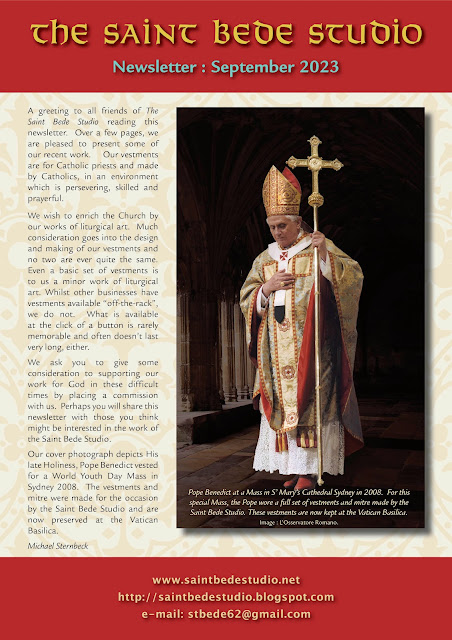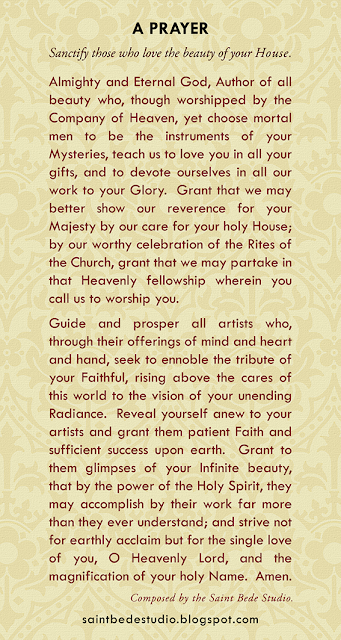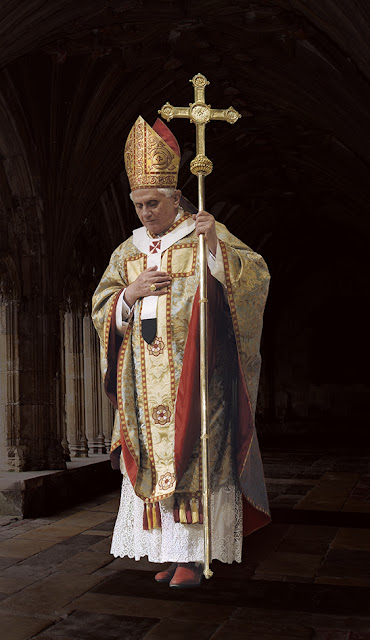 |
Sunday 31 December 2023
As 2023 draws to a close
Thursday 28 December 2023
Festal Mitre
This elegant but simple mitre is derived from the common form of mediaeval mitre, which were ornamented with braid or embroidery around the crown of the head and a corresponding ornament running up the centre towards the pointed top of the mitre. These ornaments are called, respectively, circulus and titulus.
The principal fabric of the mitre was formed from a silk brocade in the colours of ivory and muted gold. The lining was formed from silk taffeta in a shade of crimson red.
The braid forming the decoration of this mitre is a burgundy in colour, but its floriated mediaeval ornament is picked out in straw-gold.
Click on the images for an enlarged view.
Sunday 24 December 2023
In this Holy Season
Every valley shall be exalted, and every mountain and hill be made low; the crooked shall be made straight and the rough places, plain; and the Glory of the Lord shall be revealed and all flesh shall see it together, for the mouth of the Lord has spoken it.
Isaiah 40:4-5.
Michael Sternbeck
The Saint Bede Studio
December 2023
Wednesday 20 December 2023
A Prayer
We humbly beseech you, O Lord, that of your boundless mercy you would grant to your Holy Roman Church a Pontiff who, by his tender care of us, may ever find favour in your sight; and ever be honoured by your people, because of his good government of your Church, to the glory of your name. Amen.
AMDG.
Saturday 16 December 2023
Gaudete Sunday 2023
Rose-coloured vestments were never commonplace and they still are not. Many different colours have been deemed by the Church as acceptable as liturgical rose. Some of these are a salmon shade; some a silvery-pink, almost mushroom-colour; some close to what we would call Bishop's purple or fuchsia; and some red with overtones of gold.
These vestments were made from dupion silk in a quite lovely shade of rose. This dupion silk is distinctive for having weaves of two complementary shades, which appear different at alternative angles. The photographs accompanying this post shew these differing appearances. The vestments were fully lined in a taup-coloured taffeta.
The ornament was formed from a braid from the range of the Studio's unique offerings, called Saint George. The braid is in the colour of platinum and burgundy, upon a crimson background. A narrow galloon outlines the perimeter of the chasuble. Both these braids are derived from the designs of AWN Pugin.
Click on the images for an enlarged view.
Wednesday 13 December 2023
Vestments in the Season of Advent
Saturday 9 December 2023
In Honour of the Blessed Virgin Mary
This elegant but simple set of vestments was made from silk dupion; it was lined with a taffeta in a shade of teal blue.
The chasuble is in the style we call Saint Cuthbert, being a contemporary version of a mediaeval chasuble. The chasuble is very ample, being both wide and long, and is ornamented with a narrow braid in the familiar "Y" arrangement.
The braid ornamenting these vestments is a lovely braid in two shades of blue, picked-out with gold thread. This braid is outlined by a narrow galloon in a shade of pale yellow.
Click on the images for an enlarged view.
Tuesday 5 December 2023
In the Season of Advent
This distinctive set of vestments was made from silk dupion in a lighter hue of violet; it was lined with a taffeta in a very dark shade of blue. The colour of the vestment inclines towards blue; but it is distinctly violet, as distinct from purple or blue.
The chasuble is in the style we call Saint Cuthbert, being a contemporary version of a mediaeval chasuble. The chasuble is very ample, being both wide and long, and is ornamented with a narrow braid in the familiar "Y" arrangement.
The braid ornamenting these vestments is purple and ivory, upon a black base. It is complemented by a narrow galloon in a lighter shade.
Click on the images for an enlarged view.
Thursday 23 November 2023
Festal Vestments
Tuesday 21 November 2023
Salve Regina
 In this post, we are pleased to present images of a set of vestments recently made for a Catholic Cathedral in the United Kingdom. These vestments were made from a silk damask of floriated design and were lined in a taffeta of a lovely shade of sea-blue.
In this post, we are pleased to present images of a set of vestments recently made for a Catholic Cathedral in the United Kingdom. These vestments were made from a silk damask of floriated design and were lined in a taffeta of a lovely shade of sea-blue. It employs two shades of blue, one a sea blue, which is the base colour, the other Royal Blue and upon these two colours, the ornamental design is figured in (non-metallic) gold and in ivory.
Within a Royal blue monogram is a stylised design of the fleur de lis, surmounted by a golden crown. Separating these monograms is a bar of inscription with the Latin words SALVE and REGINA (Hail, O Queen).
This new braid is formed from elements of a Marian braid by the Gothic designer AWN Pugin. No matter whether you shop in Poland, India, England or America, you will not find another braid like Salve Regina. It is just one of the Saint Bede Studio's unique braids, designed by the writer of this blog and made exclusively for the Studio's use.
Click on the image for an enlarged view.
Saturday 18 November 2023
During the Month of the Holy Souls : 2
During this, the Month of the Holy Souls, the Saint Bede Studio is pleased to present sets of black vestments recently completed for our customers. The post is a continuation from the previous post.
These sets of vestments were ornamented very simply and in a colour scheme of silver and black. The clavi of the dalmatic were formed from a narrow galloon in silver and grey, whilst the apparel - at chest-height - was enhanced by the use of a black brocade. The dalmatic was lined with a silvery-grey taffeta.
Click on the images for an enlarged view.
Monday 6 November 2023
During the Month of the Holy Souls : 1
The chasuble was made according to the most ancient form of the chasuble, sometimes called the conical form. It is quite different from the Gothic Revival chasuble in that its shoulder seams are steeply sloped and very long indeed. It resembles the shape of a cope, but not open at the front.
These vestments were ornamented very simply and in a colour scheme of silver and black. The chasuble's orphrey was formed from a narrow galloon in silver and grey, whilst the chasuble's lining was formed from a silvery-grey taffeta.
The image above illustrates how a conical chasuble falls around on all sides when the arms of the celebrant are by his side.
A further post will illustrate the different ways in which the conical chasuble can be worn.
Click on the images for an enlarged view.
Please note that posts on this blog are set-up for viewing via a web-browser, not via a mobile phone.
Thursday 26 October 2023
Festal Vestments in the Gothic Revival Style
Wednesday 11 October 2023
During troubled times for the Church
A Collect from the Missal of Robert of Jumieges, 11th century.
This image of The Protection of the Mother of God is an exhibit in the Metropolitan Museum of Art.
Saturday 7 October 2023
In honour of the Blessed Virgin Mary
We should describe this braid, for those who have not followed previous posts closely. It employs two shades of blue, one a sky blue, the other Royal Blue and upon these two colours, the ornamental design is figured in (non-metallic) gold.
Within a Royal blue quatrefoil (four-leafed flower) is a stylised monogram being the letters MR. This is the Latin abbreviation of Maria Regina (Mary the Queen). It was very typical in the Mediaeval period for such monograms to appear as decorative schemes in churches and upon vestments.
These quatrefoils alternate with another emblem, which is upon a light blue base. Here is a crown emphasising the Queenship of the Blessed Virgin. Below it, in heraldic lettering, is the greeting AVE. From this is derived the name of this braid and based on the beautiful Marian antiphon Ave Maris Stella (Hail, Star of the Sea).
Running along either side of this orphrey is a row of smaller quatrefoils in gold, upon the Royal Blue base.
Although not directly-based on the work of the Gothic designer AWN Pugin, this Ave Maris Stella braid incorporates Puginesque elements. No matter whether you shop in Poland, India, England or America, you will not find another braid like Ave Maris Stella. It is just one of the Saint Bede Studio's unique braids, designed by the writer of this blog and made exclusively for the Studio's use.
In further posts, we will present some of our other unique Marian braids and a new one, recently-manufactured titled Salve Regina.
Click on the image for an enlarged view.
Wednesday 4 October 2023
Priestly Ordinations for 2023 : 1
These vestments were made from a lovely ivory-coloured English ecclesiastical brocade and lined in a muted shade of golden taffeta.
The vestments were ornamented with one of the Saint Bede Studio's unique braids called Saint Edmund, directly based on the work of the famed designer of the Gothic Revival AWN Pugin.
The appearance of this vestment is autumnal and cheerful, without being lavish.
Please pray for all newly-ordained priests.
Click on the images for an enlarged view.
Enquiries : This page.
AMDG
Tuesday 3 October 2023
Sunday 24 September 2023
The Studio Newsletter
The Studio's latest Newsletter will be sent to those on our list of contacts in coming days. Would you like to receive a copy? If so, please send an e-mail with the subject "NEWSLETTER" to our address :
AMDG
Thursday 14 September 2023
A Prayer for those who work to beautify God's House
This prayer has been composed to seek God's Blessings on the work of the Saint Bede Studio, but it is also intended for the benefit of all those who work for the beautification of God's House. Perhaps you will read this prayer regularly and share it with others.
Sunday 10 September 2023
Considering an order with the Studio for vestments?
Would you like to support our work for the beautification of the Church's liturgy? Please consider placing an order for vestments with us at this time or the near future. We would welcome your business.
Enquirers, look at this link.
This image shews His late Holiness, Pope Benedict wearing vestments made for him by the Saint Bede Studio in 2008. These vestments, together with the matching mitre are now preserved in the sacristy of Saint Peter's Basilica, Rome. Only a select few vestment-makers are given the opportunity to make vestments for the Pope and the Saint Bede Studio is among them! We are very mindful of this immense privilege.
At the Saint Bede Studio, we are a small firm of Catholics making vestments for Catholics.
Click on the images for an enlarged view.
AMDG.







